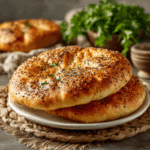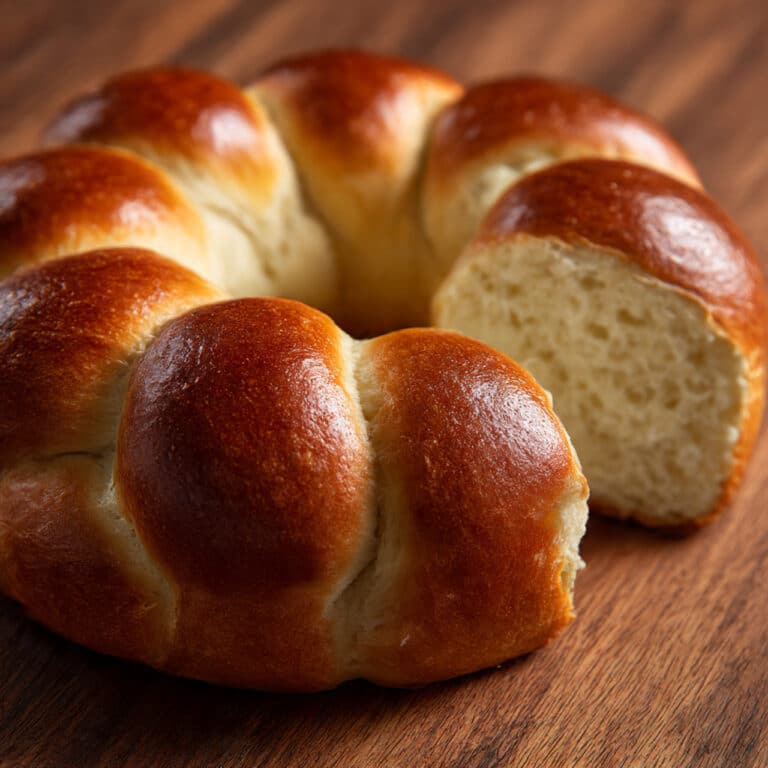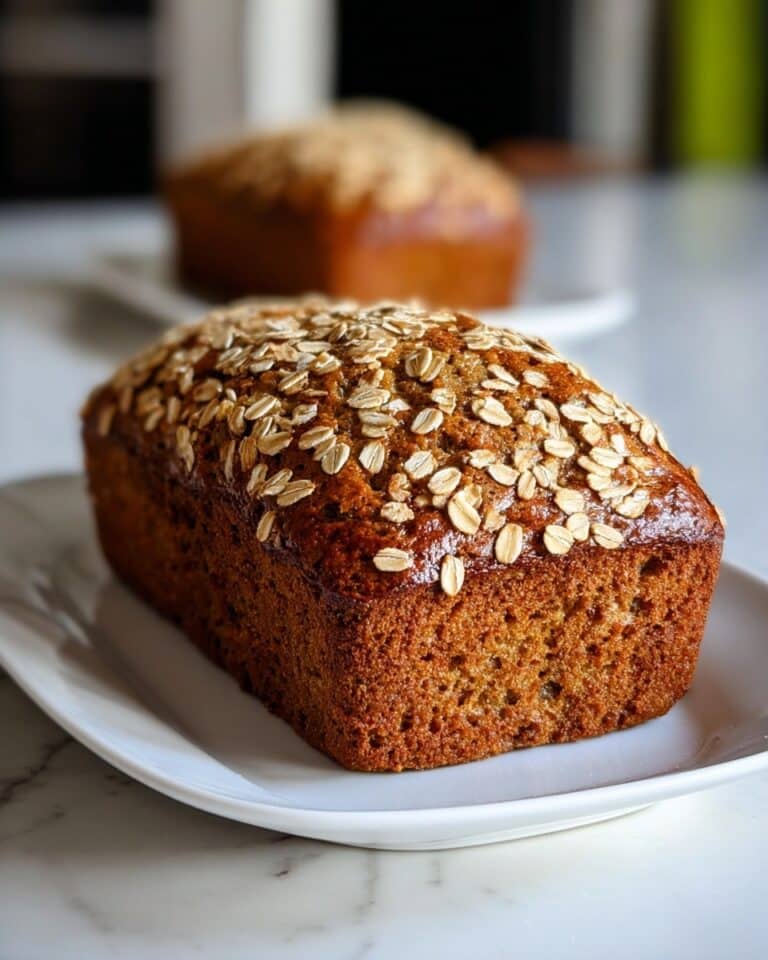Turkish Ramazan Pide (Flatbread)
Turkish Ramazan Pide is a beloved traditional flatbread often enjoyed during the holy month of Ramadan. Characterized by its golden, slightly chewy crust, pillowy interior, and a distinctive grid pattern adorned with sesame and nigella seeds, this bread is both beautiful and flavorful. Its soft texture and subtle tang from yogurt make it a versatile addition to any meal.
Why You’ll Love This Recipe
This bread is easy to make yet yields a stunning and authentic result. It’s perfect served with soups, stews, dips, or enjoyed warm with a bit of butter or olive oil. Ramazan Pide’s soft interior and aromatic crust make it a favorite for both festive and everyday meals. The simple ingredients and straightforward technique ensure that even novice bakers can achieve success.
ingredients
(Tip: You can find the complete list of ingredients and their measurements in the recipe card below.)
- all-purpose flour
- dry yeast
- sugar
- salt
- warm water
- plain yogurt
- olive oil
For the glaze:
- egg yolk
- milk
- olive oil
- sesame seeds
- nigella seeds (or black sesame seeds)
directions
- In a small bowl, combine the dry yeast, sugar, and warm water. Stir and let sit for 10 minutes until the mixture becomes foamy.
- In a large mixing bowl, whisk together the flour and salt. Add the yogurt and olive oil, then pour in the activated yeast mixture.
- Stir until a rough dough forms. Knead on a lightly floured surface for 8–10 minutes until the dough is smooth and elastic.
- Place the dough in a greased bowl, cover with a cloth or plastic wrap, and let rise in a warm place for 1 hour or until doubled in size.
- Preheat the oven to 425°F (220°C) and line a baking sheet with parchment paper.
- Divide the dough into two equal parts. Shape each into a round disk about 1/2 inch thick. Transfer to the prepared baking sheet.
- Using floured fingers, press a grid or diamond pattern into the top of each dough round.
- Mix the egg yolk, milk, and olive oil together and brush it over the tops of the dough.
- Sprinkle generously with sesame seeds and nigella seeds.
- Bake for 15–18 minutes, or until the loaves are golden brown and puffed. Let cool slightly before serving.
Servings and timing
This recipe makes 2 medium-sized flatbreads.
Preparation time: 20 minutes
Rising time: 1 hour
Baking time: 15–18 minutes
Total time: approximately 1 hour 40 minutes
Variations
- Make it whole wheat: Substitute half of the all-purpose flour with whole wheat flour for a nuttier flavor.
- Add herbs: Mix in finely chopped herbs like thyme, rosemary, or parsley to the dough for added aroma.
- Use yogurt alternatives: Replace yogurt with sour cream or a dairy-free alternative for dietary preferences.
- Top with cheese: Sprinkle a little crumbled feta or shredded cheese before baking for an enriched flavor.
- Add seeds inside: Mix sesame or nigella seeds into the dough for extra crunch and taste throughout the bread.
storage/reheating
Store leftover pide in an airtight container or bread bag at room temperature for up to 2 days.
For longer storage, freeze the cooled bread wrapped in foil or plastic wrap and place it in a freezer bag.
To reheat, warm in a 350°F (175°C) oven for 5–7 minutes or until heated through. Avoid microwaving as it may make the bread rubbery.
FAQs
What is the difference between Ramazan Pide and other flatbreads?
Ramazan Pide has a distinctive texture and flavor due to the addition of yogurt and its traditional topping of sesame and nigella seeds. It also features a characteristic scored pattern.
Can I make this without nigella seeds?
Yes. If you don’t have nigella seeds, you can substitute black sesame seeds or simply use sesame seeds alone.
Do I have to use yogurt?
Yogurt adds tenderness and a subtle tang. However, you can substitute it with sour cream, buttermilk, or a plant-based yogurt.
How do I get the signature pattern on top?
Use your floured fingertips to gently press a criss-cross or diamond pattern into the dough before baking. This traditional design also helps control the bread’s rise.
Can I use instant yeast instead of active dry yeast?
Yes. If using instant yeast, you can mix it directly into the dry ingredients without proofing in water first.
Is this bread served warm or cold?
It is best served slightly warm, but it can also be enjoyed at room temperature.
What can I serve with Ramazan Pide?
It pairs well with soups, stews, cheeses, olives, dips like hummus or baba ganoush, or simply butter and jam.
Can I make mini versions of this bread?
Yes. Divide the dough into smaller portions to make individual-sized flatbreads. Adjust baking time as needed.
How do I freeze and reheat this bread?
Wrap tightly in foil and store in a freezer-safe bag. Reheat in a 350°F (175°C) oven until warmed through.
Can I add spices to the dough?
Yes, spices such as cumin, paprika, or za’atar can be added to the dough for additional flavor.
Conclusion
Turkish Ramazan Pide is a warm, inviting bread that blends simple ingredients into something truly special. Soft on the inside with a beautifully golden crust, it’s a versatile flatbread that suits both festive occasions and everyday meals. Whether you’re baking it for Ramadan or simply to enjoy with your favorite dishes, this recipe offers authenticity and comfort in every bite.
PrintTurkish Ramazan Pide (Flatbread)
Un pain plat turc traditionnel à la mie moelleuse et moelleuse, parsemé de graines de sésame et de nigelle. Le pide du Ramadan est un incontournable du Ramadan, mais irrésistible en toute saison.
- Prep Time: 20 minutes
- Cook Time: 18 minutes
- Total Time: 1 hour 38 minutes (including rise time)
- Yield: 2 flatbreads
- Category: Bread
- Method: Baking
- Cuisine: Turkish
- Diet: Halal
Ingredients
- 3 tasses de farine tout usage
- 1 cuillère à soupe de levure sèche
- 1 cuillère à café de sucre
- 1 cuillère à café de sel
- 1 tasse d’eau tiède
- 1/3 tasse de yaourt nature
- 2 cuillères à soupe d’huile d’olive
- 1 jaune d’oeuf
- 1 cuillère à soupe de lait
- 1 cuillère à café d’huile d’olive (pour le glaçage)
- 1 cuillère à soupe de graines de sésame
- 1 cuillère à soupe de graines de nigelle (ou remplacez-les par des graines de sésame noires)
Instructions
- Dans un petit bol, mélanger la levure, le sucre et l’eau tiède. Laisser reposer 10 minutes jusqu’à ce que le mélange mousse.
- Dans un grand bol, mélanger la farine et le sel. Ajouter le yaourt et l’huile d’olive, puis verser le mélange de levure.
- Mélanger jusqu’à obtenir une pâte. Pétrir pendant 8 à 10 minutes jusqu’à obtenir une pâte lisse et élastique.
- Couvrir la pâte et laisser lever dans un endroit chaud pendant 1 heure ou jusqu’à ce qu’elle double de volume.
- Préchauffer le four à 220 °C. Recouvrir une plaque à pâtisserie de papier sulfurisé.
- Divisez la pâte en deux parts égales. Aplatissez chaque part en un disque rond d’environ 1,25 cm d’épaisseur.
- Avec les doigts farinés, appuyez sur un motif de grille sur la surface de la pâte.
- Mélangez le jaune d’œuf, le lait et l’huile d’olive pour le glaçage et badigeonnez-en la pâte.
- Saupoudrer de graines de sésame et de nigelle.
- Enfournez pendant 15 à 18 minutes jusqu’à ce que le gâteau soit doré. Laissez refroidir légèrement avant de servir.
Notes
- À déguster de préférence chaud avec du beurre ou de l’huile d’olive.
- Peut être congelé après cuisson et réchauffé au four.
- Utilisez du yaourt grec pour une texture plus riche.
- Se marie bien avec les soupes, les ragoûts ou les tartinades au fromage.
Nutrition
- Serving Size: 1/4 flatbread
- Calories: 230
- Sugar: 1g
- Sodium: 280mg
- Fat: 6g
- Saturated Fat: 1g
- Unsaturated Fat: 5g
- Trans Fat: 0g
- Carbohydrates: 36g
- Fiber: 2g
- Protein: 6g
- Cholesterol: 20mg
Keywords: ramazan pide, Turkish bread, flatbread, Ramadan bread, sesame, nigella seeds, Turkish cuisine






